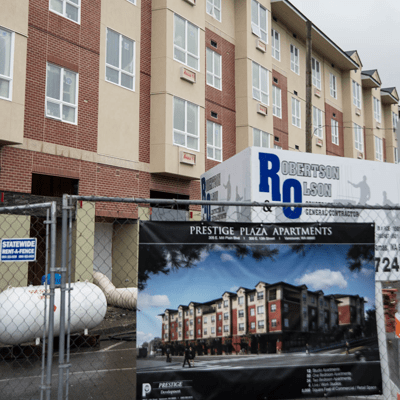Bomar also said that there has been a “huge amount of permits coming through” (19 permits were issued in August alone) for multi-family projects. These, he said, will serve to relieve some pent up demand in the rental market, but will also create serious competition for existing rentals.
“I think the economy is going to get better,” added Prestige President Elie Kassab. “Companies will start hiring more people and they need a place to live.”
Ron Frederiksen, president of RSV Building Solutions, said he expected the first quarter of 2014 to be active, but predicts a slowdown the rest of the year 2014. However, he added, his research indicates that 2015 through 2017 will see a two- to three-percent annual increase in construction activity.
“Once we navigate 2014, we’ll see modest steady growth,” said Frederiksen.
Kassab said he expected the multi-family housing market will continue to increase through 2020, due to several factors. First, college graduates who have been living with their families during the recession will find employment and will be looking for their own living quarters. Second, baby boomers whose children have moved out will be looking to simplify their lives by downsizing their homes.
Other “bright spots” for 2014 and beyond, said Frederiksen, will include warehouse construction, office buildings and commercial construction. Nationally, Frederiksen said, warehouse construction is predicted to increase 10 percent, driven by declining vacancy rates. As an example, RSV recently helped a Portland company move to Vancouver – there were no available warehouses, and only a single available site upon which to build one.
“We still have big challenges with land availability and wetland rules,” said Frederiksen.
Other constraints on construction, said Cornell Rotschy, vice president of Rotschy Inc., include the “drying up” of municipality funding for public works projects, and “difficulties in obtaining financing.”
“We’re cautious about government spending – we don’t see a whole bunch of infrastructure projects on the books for the next three to five years,” said Nutter. “And that’s a big part of our business.”
“We continue to have terrible struggles with lending,” noted Frederiksen. “At a lot of the banks, the regulators are running the bank, not the bankers.”
Frederiksen also cited the current appraisal process as a hurdle to both residential and commercial development. He explained that if the buyer deals directly with the builder, such as private transactions and all-cash deals, the data never gets into the MLS. In many cases, the majority of the sales appraisers are looking at are short sales and distressed sales, and banks cannot deal directly with the appraiser – instead, there is a government entity serving as a middleman. Frederiksen said that builders need to find a way to “communicate more clearly and provide appraisers with accurate information.”
County staffing and training are two other areas that concern local builders.
“It’s hard to get qualified or experienced employees,” said Nutter. “We’re having to do a lot more training and the cost of training is a big factor for us.”
Nutter said that almost ten employees in his firm have retired in the last two years, and more will retire soon. Other factors that contribute to the dearth of available workers include those that exited the industry during the recession and younger workers who, due to lack of available jobs, never got the on-the-job training they would normally have received during a busier construction market.
“We’ve driven costs down so far that now we hit a delta,” said Nutter. “We don’t have enough money for training, but we have to train to expand. So our costs will go up.”
Frederiksen said that Clark County’s development fee holiday helped the medical building his firm is building on 139th Street “become reality,” but he is concerned that if construction picks up even more, current county staffing levels will be insufficient to handle the workload.
“We’re hoping that commissioners understand that as the economy recovers, they are committed to providing funding for additional staffing,” said Frederiksen. “Doing more with less sounds great, but it can cause a lot of stress.”
Despite the concerns, the overall attitude in the industry is positive.
“Overall, we’re upbeat about the construction market in southwest Washington,” said Rotschy.
{jathumbnail off}






